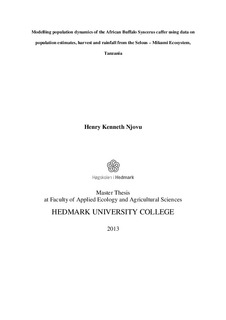Modelling population dynamics of the African Buffalo Syncerus caffer using data on population estimates, harvest and rainfall from the Selous – Mikumi Ecosystem, Tanzania
Master thesis
Permanent lenke
http://hdl.handle.net/11250/132243Utgivelsesdato
2013Metadata
Vis full innførselSamlinger
Sammendrag
Knowledge on the population dynamics of African buffalo is a prerequisite for developing its successful harvest strategy. Acquiring such knowledge requires among others the use of population models which reveals important demographic information and suggests some management actions to be taken. This study aims at developing an understanding on how to take population estimates and influences of rainfall into account when developing harvest strategy. I hypothesize that annual quota would be influenced by population estimates and that population estimates would be influenced by rainfall. I used data on the buffalo population estimates, annual quota, harvest, and rainfall as well as survival and fecundity rates obtained from different sources. The study employs the use of the package Popbio in the statistical program R, to construct and analyze an age-specific Leslie matrix population model. Tracing study on the increase phases of the Selous – Mikumi population estimates reveals that high annual average growth rates 1.16 and 1.34 could be explained by stable and unstable age distribution respectively. Results suggest population growth is sensitive to changes in survival and fecundity rate of adults and juveniles. Annual harvest level is controlled by the annual harvest quota, which is set independently on the amount of rainfall and population estimates. This study shows empirically that age-specific population estimates provide detailed demographic information, which could be used to make informed decisions. I recommend the use of the method that estimates detectability and is capable of providing age and sex specific demographic information, which would facilitate identification of the causal factors overriding population changes. Finally, in order to halt buffalo population decline it is important that harvest strategy should not allow harvesting of adult and juvenile age class, instead calf, sub-adult and senescent age classes could be harvested.
Beskrivelse
Master in applied ecology. Evenstad 2013
